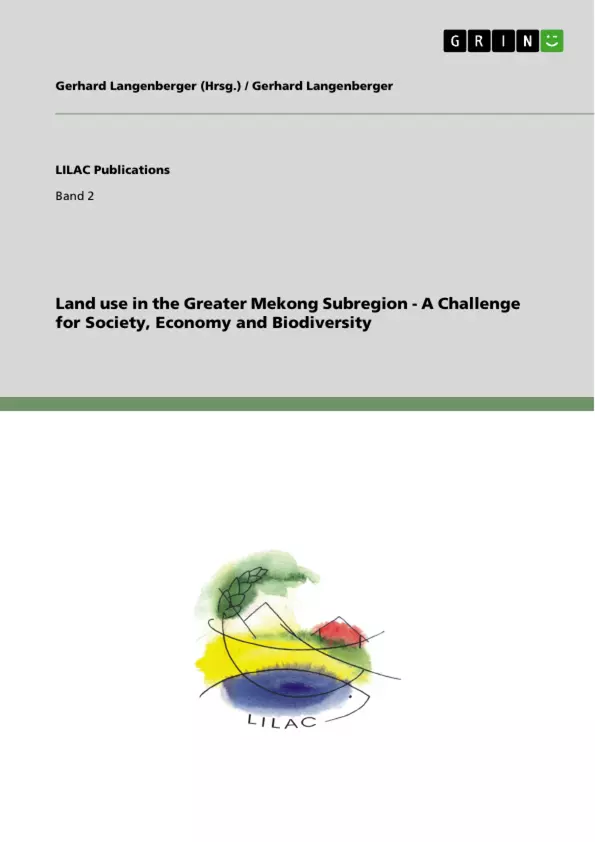Southwest China has undergone serious changes in recent years. In this respect, it is representative of large areas in South Asia and in particular the ‚Greater Mekong Subregion’ (GMS) with its 300 Mio inhabitants. The GMS is an informal cooperation of Thailand, Lao PDR, Myanmar, Cambodia, Viet Nam, and the P.R. China (Yunnan and Guangxi Province) to promote the development of the region.
While being far off from global developments and characterized by subsistence economy in the past, the region turned out to become one of the most dynamic areas worldwide. A new highway system connects the countries of the GMS, and the area is opened up to international markets. Cash crops such as rubber, which plays already a significant role in local economy, will become even more attractive and speed up land-use cover change (LUCC) with all its consequences for man and his environment.
As a consequence of the dynamic development, socio-economic and cultural traditions are challenged, leading to a rapid change or even disappearance of traditional land-use systems. The consequences are manifold and affect people and their livelihood, as well as the century-old cultural landscape with its high (agro-)biodiversity.
Inhaltsverzeichnis (Table of Contents)
- Background
- Symposium Programme
- Presentations
- Mo et al.: Limited impact on plant diversity and composition of traditional forest management in a tropical seasonal rainforest in SW China
- Liu et al: Land-use and plant diversity a case study from the NRWNNR
- Zhu, H.: Vegetation and flora of Xishuangbanna, Southern Yunnan
- Meng et al.: Ground beetle (Carabidae) communities and species distribution in a dynamic landscape mosaic of tropical Yunnan, SW China
- Meng et al.: Responses of insect pollinators (hoverflies and wild bees) to land-use change in tropical Yunnan, SW China.
- (Warren, M.: Soil carbon and nitrogen in the Nabanhe mosaic)
- Ghorbani et al.: Non-timber forest products in Naban River Watershed National Nature Reserve (NRWNNR): a case of medicinal and food plants
- Li & Li: Soil quality evaluation of different land use types in Naban River Watershed National Nature Reserve
- Wolff et al.: Carbon sequestration potentials and nutrient status under different land uses in Xishuangbanna, Southwest China
Zielsetzung und Themenschwerpunkte (Objectives and Key Themes)
This book of abstracts presents the findings of the Sino-German research project "Living Landscapes China" (LILAC), which focuses on the challenges of land-use change in the Greater Mekong Subregion (GMS). The project aims to collect valuable baseline data on the impacts of land-use change on biodiversity, cultural landscapes, and socio-economic aspects in the region. The project utilizes a holistic approach, combining environmental and socio-economic perspectives to understand the complex interactions within the GMS.
- Land-use change and its impact on biodiversity
- Traditional land-use practices and their contribution to conservation
- The role of non-timber forest products in local livelihoods
- Socio-economic drivers of land-use change
- Sustainable land-use management strategies
Zusammenfassung der Kapitel (Chapter Summaries)
The book of abstracts features contributions from various researchers investigating diverse aspects of land-use change in the GMS. The presentations explore the impacts of land-use change on plant diversity, insect pollinator communities, soil quality, and the availability of non-timber forest products.
For example, Mo et al. examine the impact of traditional forest management practices on plant diversity in a tropical seasonal rainforest in SW China, while Liu et al. investigate the relationship between land-use and plant diversity in the Naban River Watershed National Nature Reserve (NRWNNR). Meng et al. explore the responses of ground beetle and insect pollinator communities to land-use change in tropical Yunnan, SW China. The book of abstracts also features research on soil carbon and nitrogen dynamics, soil quality assessment, and the potential for carbon sequestration under different land-use types.
Schlüsselwörter (Keywords)
Land-use change, biodiversity, cultural landscapes, socio-economic factors, Greater Mekong Subregion (GMS), traditional land-use, non-timber forest products, soil quality, carbon sequestration, tropical Yunnan, SW China, conservation.
- Quote paper
- Dr. Gerhard Langenberger (Author), Gerhard Langenberger (Series editor), 2010, Land use in the Greater Mekong Subregion - A Challenge for Society, Economy and Biodiversity, Munich, GRIN Verlag, https://www.grin.com/document/163703



